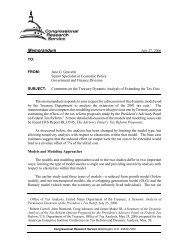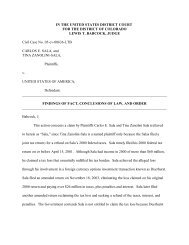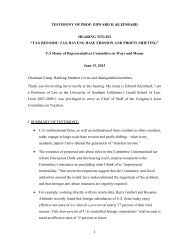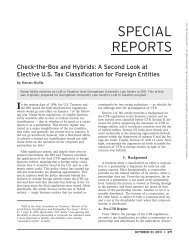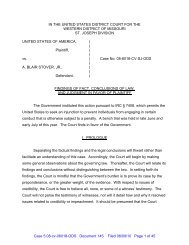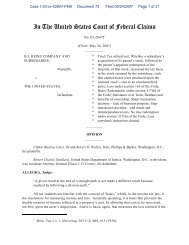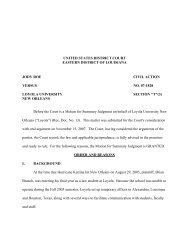Targeted Allocations Hit the Spot
Targeted Allocations Hit the Spot
Targeted Allocations Hit the Spot
Create successful ePaper yourself
Turn your PDF publications into a flip-book with our unique Google optimized e-Paper software.
COMMENTARY / SPECIAL REPORT<br />
rarely get as worked up about how cash on liquidation<br />
should be distributed, o<strong>the</strong>r than as a subset<br />
of <strong>the</strong> business terms for distributions generally or<br />
capital events generally.<br />
Fourth, as discussed, partners often buy and sell<br />
partnership interests without paying much attention<br />
to capital account balances.<br />
And fifth, <strong>the</strong> economic effect tests do not take<br />
into account time value of money principles, which<br />
are really <strong>the</strong> heart of economics.<br />
Observation: The safe harbor economic effect<br />
test takes a somewhat simplistic snapshot of<br />
partnership economics to determine whe<strong>the</strong>r a<br />
partnership allocation has economic effect.<br />
This rough justice was necessary for <strong>the</strong> rules<br />
to be administrable. But since <strong>the</strong> rules represent<br />
only rough justice, perhaps it is appropriate<br />
to consider whe<strong>the</strong>r <strong>the</strong>re should be<br />
alternative approaches.<br />
B. Alternate Test for Economic Effect<br />
1. In general. Most partnerships do not contain a<br />
deficit restoration obligation and <strong>the</strong>refore seek to<br />
satisfy <strong>the</strong> so-called alternate test for economic<br />
effect. 14 The alternate economic effect safe harbor<br />
requires <strong>the</strong> same capital account maintenance and<br />
capital liquidation as under <strong>the</strong> basic economic<br />
effect safe harbor, but it does not require deficit<br />
restoration. The trade-off for eliminating deficit<br />
restoration is that partners without a deficit restoration<br />
obligation are permitted loss allocations only<br />
up to <strong>the</strong> amount of <strong>the</strong>ir capital accounts. For this<br />
purpose, a partner’s capital account is adjusted to<br />
include <strong>the</strong> partner’s share of minimum gain (or<br />
partner minimum gain), which is treated as a<br />
deemed deficit restoration obligation. (Minimum<br />
gain is discussed in Part II.E below.) Also, capital<br />
accounts are adjusted for some anticipatory items.<br />
See II.B.2 below.<br />
The alternate test for economic effect does not<br />
affect loss allocations of nonrecourse deductions<br />
and partner nonrecourse deductions. (Nonrecourse<br />
deductions are discussed in Part II.E below.) Those<br />
deductions have <strong>the</strong>ir own allocation rules independent<br />
of <strong>the</strong> substantial economic effect test.<br />
As a technical matter, for partnerships meeting<br />
<strong>the</strong> alternate safe harbor test, <strong>the</strong> partnership allocation<br />
is deemed to have economic effect to <strong>the</strong><br />
extent <strong>the</strong> allocation does not cause or increase a<br />
deficit balance in <strong>the</strong> partner’s capital account in<br />
excess of <strong>the</strong> deemed deficit restoration obligation<br />
amount (via minimum gain and partner minimum<br />
gain chargeback) plus any actual deficit restoration<br />
obligation.<br />
2. Anticipatory downward capital account adjustments.<br />
Under this alternate economic effect test,<br />
some downward adjustments are made to a partner’s<br />
capital account that reduce <strong>the</strong> partner’s ability<br />
to absorb losses under section 704(b). These<br />
adjustments provide for hypo<strong>the</strong>tical reductions in<br />
<strong>the</strong> capital account of a partner for specified adjustments,<br />
allocations, or distributions that are reasonably<br />
expected to be made as of <strong>the</strong> end of <strong>the</strong> year<br />
in which <strong>the</strong> allocation is to be made. These adjustments<br />
include reasonably expected depletion allowances,<br />
reasonably expected loss and deduction<br />
allowances, and reasonably expected distributions<br />
in excess of corresponding increases in capital account.<br />
15<br />
Depletion: The capital account must be reduced<br />
for all reasonably expected (whatever<br />
that means) depletion allowances for oil and<br />
gas properties. Although this provision seems<br />
odd, it is needed because depletion is deductible<br />
at <strong>the</strong> partner level as opposed to <strong>the</strong><br />
partnership level.<br />
Reasonably expected future deductions:<br />
Capital accounts must be reduced for future<br />
allocations of loss or deductions that are reasonably<br />
expected to be made under section<br />
704(e)(2) (family partnerships), section 706(d)<br />
(changes in interests during <strong>the</strong> year), and reg.<br />
section 1.751-1(b)(2)(ii) (‘‘hot’’ assets).<br />
Distributions: The capital account must be<br />
reduced for distributions that are reasonably<br />
expected to be made after year-end to <strong>the</strong><br />
extent those distributions exceed any reasonably<br />
expected offsetting capital account increases<br />
attributable to profits for <strong>the</strong> year.<br />
For determining whe<strong>the</strong>r reasonably expected<br />
distributions will be matched by reasonably expected<br />
profit allocations, <strong>the</strong> presumed value of<br />
property is tax basis (book value), not FMV. The<br />
effect is that if <strong>the</strong> partnership has cash that it<br />
reasonably expects to distribute next year, profits<br />
from a sale it also reasonably expects to make<br />
cannot be taken into account under <strong>the</strong> ‘‘value<br />
equals basis rule’’ to eliminate <strong>the</strong> need for <strong>the</strong><br />
capital account adjustment. By contrast, no adjustment<br />
is required if <strong>the</strong> cash reasonably expected to<br />
be distributed arises from <strong>the</strong> sale itself, because <strong>the</strong><br />
value-equals-basis presumption applies to both <strong>the</strong><br />
availability of <strong>the</strong> cash and <strong>the</strong> amount of profits<br />
reasonably projected.<br />
3. Qualified income offset. As discussed, reg. section<br />
1.704-1(b)(2)(ii) requires capital accounts to be<br />
(C) Tax Analysts 2010. All rights reserved. Tax Analysts does not claim copyright in any public domain or third party content.<br />
14 Reg. section 1.704-1(b)(2)(ii)(D).<br />
15 Reg. section 1.704-1(b)(2)(ii)(d)(4) through (d)(6).<br />
94 TAX NOTES, October 4, 2010







